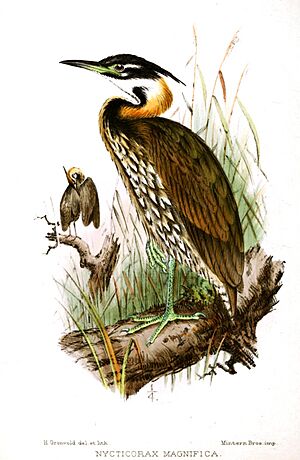White-eared night heron facts for kids
Quick facts for kids White-eared night heron |
|
|---|---|
 |
|
| Conservation status | |
| Scientific classification | |
| Genus: |
Oroanassa
|
| Species: |
magnifica
|
| Synonyms | |
|
|
The white-eared night heron (Oroanassa magnifica) is a special type of heron bird. It belongs to the Ardeidae family. You can find this bird mainly in southern China and northern Vietnam. In 2018, it was also seen in Valmiki National Park in India. This heron is in danger because its natural home is being lost or broken up.
Contents
How It Got Its Name
The white-eared night heron was first found in Hainan by John Whitehead. A scientist named William Robert Ogilvie-Grant officially described it in 1899. He gave it the scientific name Nycticorax magnifica.
Where It Lives
This heron lives in southern China and northern Vietnam. The area where it can be found is very large. It is estimated to be about 2.18 million square kilometers. For a long time, people only knew about 20 places where these birds lived. But from 2001 to 2011, surveys found them in over 30 more spots. This means their known home range is much bigger than once thought. These birds naturally live in warm, wet forests and near rivers. They have also been seen in areas changed by humans.
What It Looks Like
The white-eared night heron is about 54 to 56 centimeters long. That's about the length of a large ruler.
The male bird is mostly dark brownish-black. The sides of its neck are a reddish-brown color. The skin around its eyes (called lores) is yellow, and its beak is black. Its eyes are a bright yellow-orange. The top of its head and the back of its neck are dark, almost black. It has white stripes behind its eyes and on its throat. Its belly and chest are brown with white stripes. Its legs are green.
The female bird looks a lot like the male. However, the patterns on her head and neck are not as clear. She also has some whitish stripes on her back and wings.
Young herons, called juveniles, look similar to the female. But their feathers are browner, and they have buff-colored spots.
Daily Life and What It Eats
Like other night herons, this bird is mostly active at night. It hunts for its food when the sun goes down. It eats fish, small shrimp, and other tiny creatures without backbones.
When it wants to mark its territory, it makes a deep, rough sound. It sounds like a "whoaa" and lasts for about 0.3 seconds. It repeats this call every 5 to 15 seconds.
Reproduction and Life Cycle
White-eared night herons have been seen breeding in both Vietnam and China. A female usually lays 3 to 5 eggs. In China, baby birds have been seen hatching in May. The eggs take about 25 days to hatch. In Vietnam, young birds have been seen flying from the nest in late April. It seems they start breeding earlier in Vietnam than in China.
Their nest is shaped like a round tray. One study found that young birds stayed in the nest for more than two months after hatching. This is a longer time than most other types of herons.
Why It Needs Our Help
The IUCN Red List is a list that shows which animals are in danger. They have listed the white-eared night heron as an endangered species. This means its population is small, spread out, and getting smaller. In the 1990s, this bird was thought to be very rare. It was even listed as "critically endangered," which is the highest level of danger. But in 2000, it was moved to "endangered" because more birds were found.
Scientists believe there are only about 250 to 999 adult birds left. The total number of all white-eared night herons is estimated to be between 350 and 1500.
This bird is in danger because of several things. Forests where they live are being cut down. People sometimes hunt them. Too much fishing can reduce their food supply. Also, water pollution harms their homes. Even though new places where they live have been found, their numbers are likely still going down because of these threats.
The white-eared night heron is a protected species in China. It lives in protected areas in both China and Vietnam. Some of these places include the Chebaling National Nature Reserve and Ba Be National Park. These protected areas help keep the birds safe.


